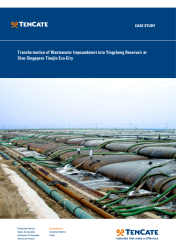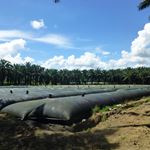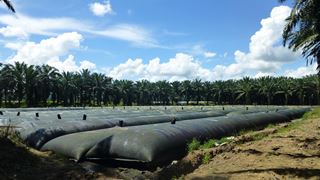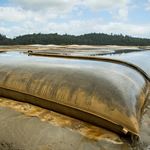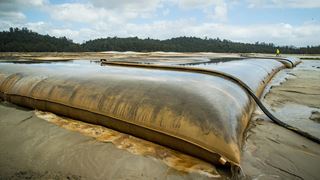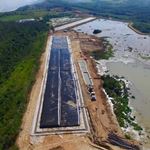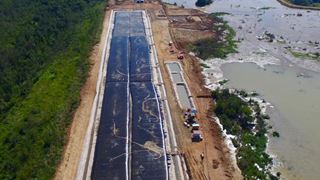Case story
Transformation of Wastewater Impoundment into YingCheng Reservoir at Sino - Singapore TianJin Eco-City
Project Data
| Project | Transformation of Wastewater Impoundment |
| Location | TianJin, China. |
| Contractor | CCCC Tianjin Dredging Co., Ltd. |
| Products used | Geotube® Containers |
Project Background
Tianjin Eco-City in China is a 30-square-kilometer modern township project under joint development by the governments of Singapore and China. Located 40 km from Tianjin, 150 km Southeast of Beijing in Northeast China, the project is scheduled to build 100,000 sustainable homes for 350,000 residents by the time the entire project is completed around 2020.
Tianjin Eco-City will use sustainable technologies, such as solar and wind power, plus innovative wastewater treatment and seawater desalination to reduce carbon footprints. Tianjin Eco-City is designed to be ecologically friendly with existing wetlands and biodiversity preserved or improved. Tianjin Eco-City’s vision is to be a thriving city which is socially harmonious, environmentally-friendly and resource efficient. The development aims to improve the living environment and to build an eco-culture that will serve as a role model for future developments in China.
The Wastewater Impoundment and Cleanup Plan
In early 1976 the Hangu District Council converted a low lying area into a wastewater impoundment lake. The wastewater lake was created by the construction of a 3m high perimeter earth dyke. The lake covers an area of about 3.0 km2 with an impoundment capacity of 5.6 million m3. From mid-1976 this wastewater impoundment lake began receiving untreated domestic and industrial wastewater from Hangu District, pumped in through underground pipes. The water and sediments are contaminated with mercury, arsenic, copper, cadmium, hexachlorobenzene and DDT along with high levels of raw sewage.
Integral to the development of Tianjin Eco-City is the plan to remediate the wastewater impoundment lake. The project to turn the wastewater impoundment area into an ecologically friendly reservoir lake was projected to cost USD 230 million. A total of about 5 million m3 of contaminated sediments required to be dredged and disposed of as part of the lake remediation programme. The contaminated water would be treated at the proposed water treatment plant for Tianjin Eco-City to be built beside the impoundment lake.
The Geotube® Dewatering and Containment Solution
Geotube® dewatering containers were used to contain the dredged slurry and dewater the material to a consistency similar to compacted borrowed material to form a mound on a reclaimed area along the shoreline. This was deemed the most attractive solution as the dredged contaminated sediments are put to beneficial use.
Trials to Validate the Geotube® Solution
A series of tests were performed to determine the ideal choice of dewatering fabric and chemical accelerant. This was followed with a full-scale prototype test to fully assess the performance of the dewatering tube system and to arrive at s. The full-scale prototype test confirmed the effectiveness of the Geotube® dewatering technology and its ability to manage huge quantity of dredged contaminated sediments within a short period of time.
The Geotube® Dewatering Platform
The dewatering tube facility for the treatment of the contaminated sediments was located on a site reclaimed from the Western side of the impoundment lake. The reclaimed area approximates 120,000 m2 with a maximum length about 760 m and a maximum width about 230 m. The dewatering facility was designed according to the principles of a landfill; having a geomembrane liner for liquid isolation and a drainage system above this liner for drainage, collection, and removal of the effluent water. Earthfill was placed above the top geotextile reinforcement layer and compacted to form the base for the laying of the HDPE geomembrane liner. Above the geomembrane liner a nonwoven geotextile cushion layer was laid before drainage aggregate was placed on top. The Geotube® dewatering platform was constructed in early 2010.
The Geotube® Dewatering Operations
Three dredges with a combined pumping capacity of 3,000 m3/h were deployed for the supply of sediment slurry to the dewatering platform. Effectively the pumping averaged between 1,500 and 2,000 m3/h. The sediment slurry was supplied by a floating pipeline across the surface of the impoundment lake that was then connected into an onshore pipeline network. Tap off steel pipe outlets of 160 mm diameter with gate control valves were positioned in sets of six at convenient locations along the onshore incoming slurry pipelines. Generally, at any time six tubes were filled simultaneously, keeping the filling rate at between 250 and 300 m3/h.
When these tubes were filled to the control height, the control valves were shut while sediment slurry was diverted to the adjacent battery of six tubes laid out ahead of time. When the filled tubes had dewatered for some time and reduced in height, they were filled again to the control height. This repeated filling and dewatering was controlled by the adjustment of the manifold valve system until the target solids concentration of 50% in the tube was achieved. Once this was achieved, the next layer of tubes was then deployed. The process was then repeated until completion of dewatering. Geotube® dewatering works began in May 2010 and was completed by end October 2010.
Effluent and Lake Water Treatment
Five water pump units, each with pumping capacity of 350m3/h, situated at five sump locations, were used to pump the effluent water discharged from the dewatering tubes back into the impoundment. The water in the impoundment area was extracted and treated at the new water treatment plant.
The Eco-Transformation Works
Once the tubes had dewatered, general soil fill was used to cover over the geotextile tubes and form a smooth, graded surface for the mound core. The final capping consisted of a HDPE geomembrane liner laid over the prepared soil surface with a soil cover placed on top of the geomembrane liner. The capping layer for the Geotube® containers was placed around mid-2011.
When the impoundment area was pumped fully dry, earthworks were carried out to reshape the lake. Following that, the new lake was re-impounded wilth clean water. The Geotube® mound would eventually be landscaped and turned into recreational parkland.
